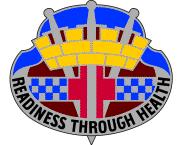US Army Dental Activity Fort Stewart: Difference between revisions
Knorrepoes (talk | contribs) m (Text replacement - "{{media}}↵" to "") |
Knorrepoes (talk | contribs) m (Text replacement - "{{us}}↵" to "") |
||
| Line 1: | Line 1: | ||
''' {{uc:{{PAGENAME}}}} ''' | ''' {{uc:{{PAGENAME}}}} ''' | ||
Revision as of 12:52, 27 December 2022
US ARMY DENTAL ACTIVITY FORT STEWART
Official blazon
Distinctive Unit Insignia. Description: A silver color metal and enamel device 1 1/8 inches (2.86cm) in height overall consisting of a red Greek cross, its lateral arms coincident with a horizontal bar checkered silver and blue; above the cross a yellow castle tower masoned silver and enclosing three silver swords with points conjoined in base and the central sword blade passing front center of the cross all on a field of maroon enclosed in base by a silver scroll inscribed in black with the words "READINESS THROUGH HEALTH," the scroll reversed in blue at either side of the castle tower and passing above the tower and behind the sword hilts.
Origin/meaning
Maroon and white are the colors used for the U.S. Army Dental Corps. Gold and silver are the two precious metals closely associated with dentistry and the red cross is emblematic of aid and assistance. The three swords enclosed by the embattled tower, are symbolic of military protection, strength and preparedness. The crenellations of the tower refer to the various fields comprising the dental profession and the checkered bar refers to the processes and technology involved; it further alludes to the coats of arms of the Stewart Clan of Scotland, ancestors of General Daniel Stewart, Revolutionary War hero and namesake of Fort Stewart.
The Distinctive Unit Insignia was approved on 14 November 1980
Literature: Image and Information from The Institute of Heraldry, US Army.
